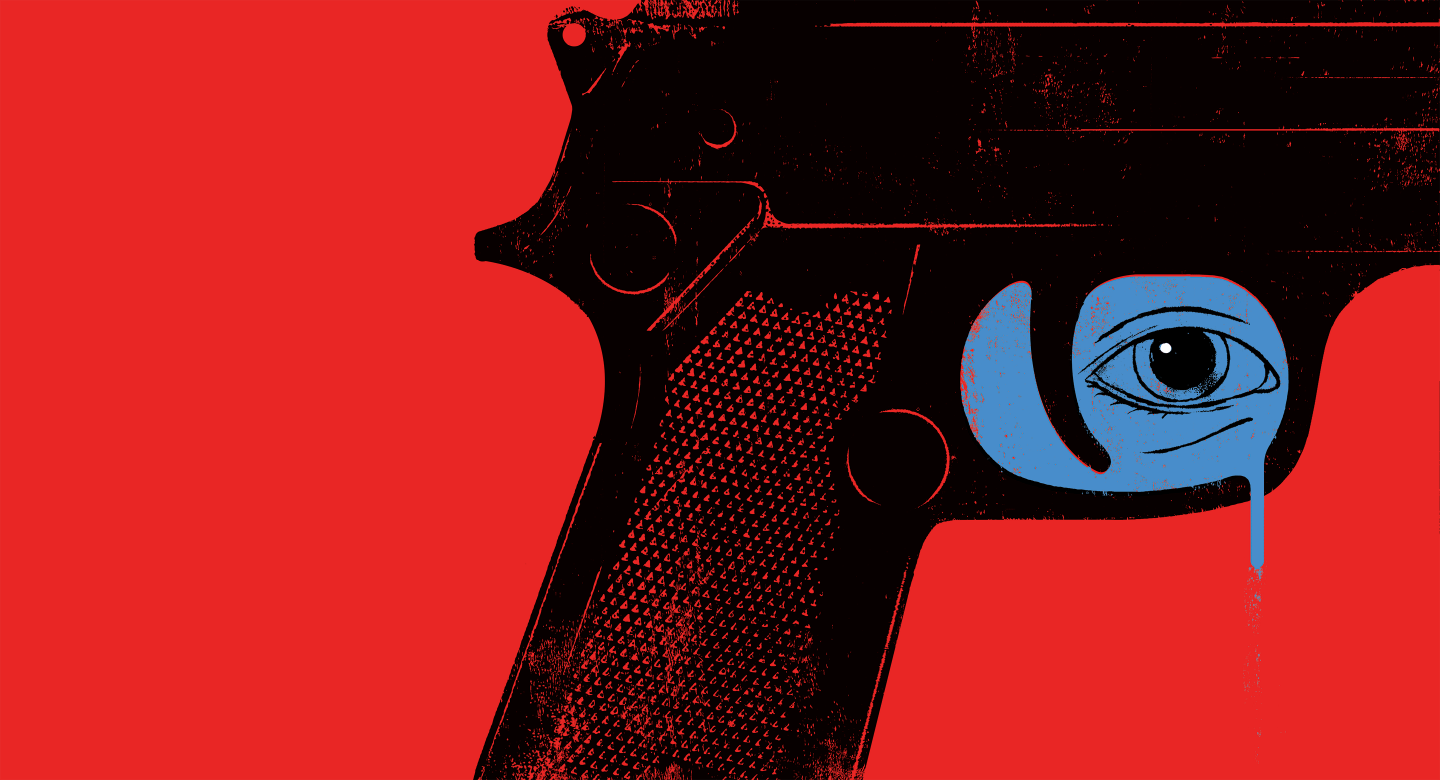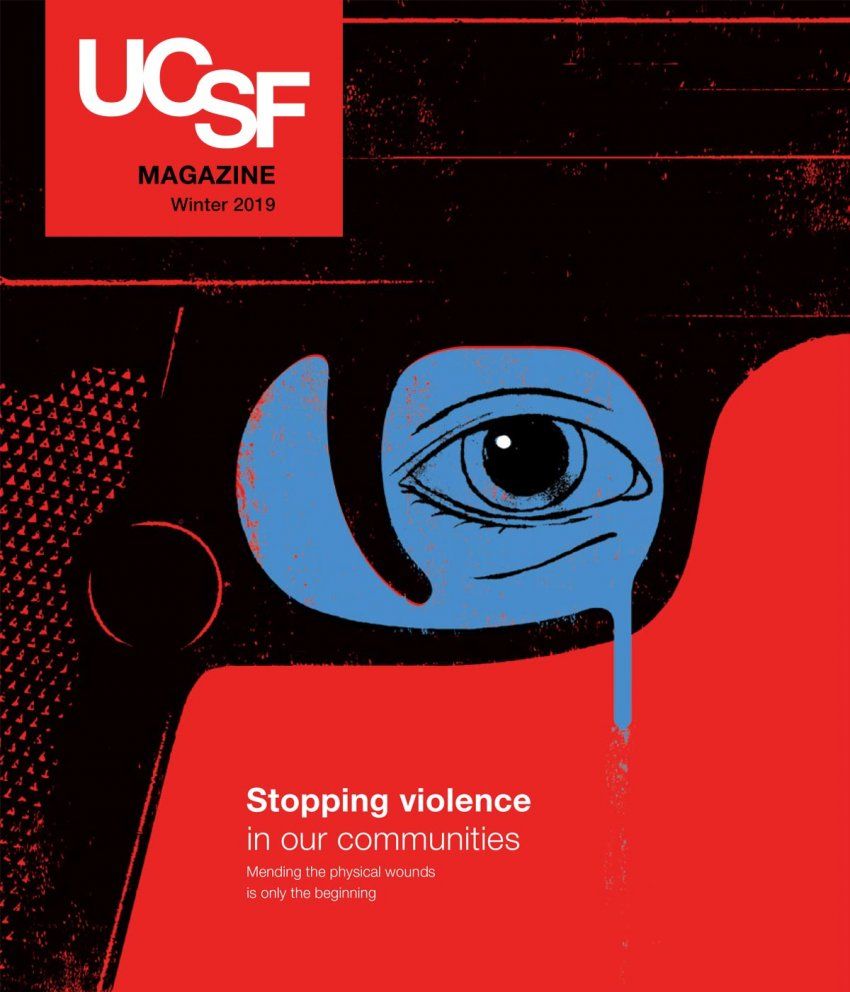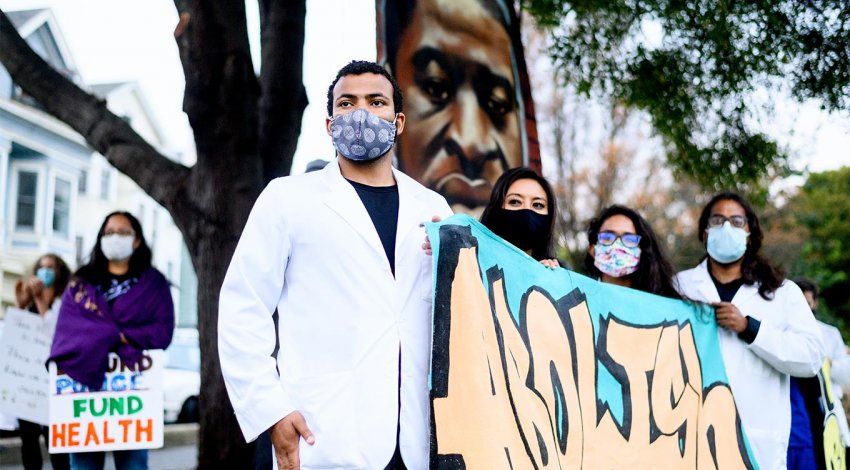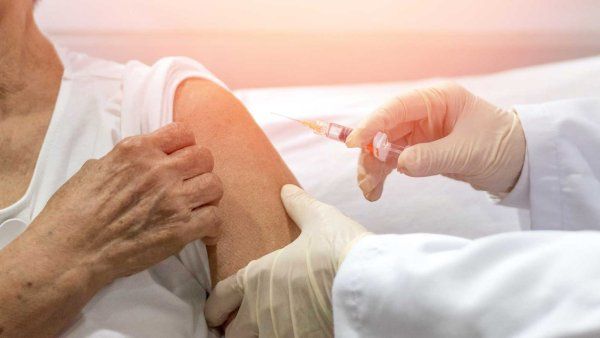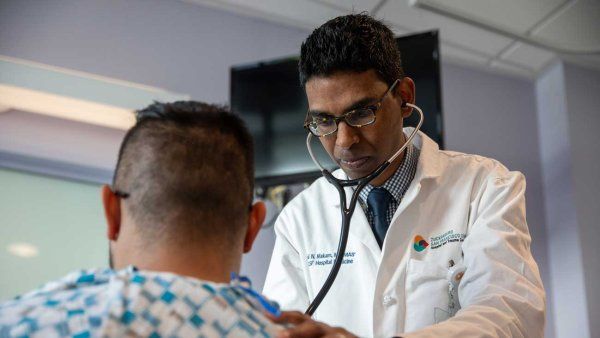
Jamal was in a good place. He was enrolled in a program that employed him while he was earning his high school equivalency degree. He enjoyed the work – doing landscaping all over the city. He had made good friends, he liked having money in his pocket, and he was doing something positive.
Until he was shot in the face.
Jamal, then 24 years old, was shopping for a shirt after work in downtown San Francisco when a car pulled up to the curb next to him. The window rolled down, and the passenger called his name. Jamal turned and walked toward the car. The bullet was probably already entering the barrel of the pistol when he caught a glimpse of the shooter – someone he had never seen before and hasn’t seen since. The bullet tore Jamal’s mouth from his face. An ambulance came, and the crew strapped him to a gurney. “I had to fight with the medics,” Jamal recalls. “I was choking from the blood, and they were forcing me to lie on my back. I kept thinking, ‘Don’t let me die here. I don’t wanna die.’”
When he awoke from a coma several weeks later, Jamal was in the ICU at Zuckerberg San Francisco General Hospital and Trauma Center (ZSFG). “That’s when I saw Mike Texada for the first time,” says Jamal, who is now 31. “He kept looking in on me without saying anything. I was so traumatized that I thought he might be trying to hurt me.” Texada is hard to miss. He has the brawn of a football player, with broad, muscular shoulders, and the intensity of a man who has no time to waste. His beeper had gone off when Jamal hit the trauma bay, just as it does every time someone with a bullet or stab wound enters the ZSFG Emergency Department. As a case manager for the UCSF Wraparound Project, a hospital-based violence prevention program, Texada checks in on victims of violence who range in age from 10 to 35 and come from the most underserved parts of the city. He makes contact early so he can gauge whether patients are open to his help finding a way out of a life or associations that came dangerously close to killing them.
“I took my time introducing myself,” recalls Texada of his early contact with Jamal. He waited until Jamal’s father and uncle were in the room. “I could tell he was afraid of me, and it was understandable,” Texada says. “Jamal didn’t know who had shot him. Could have been me.” Texada explained to Jamal and his relatives that Wraparound could connect them with services that would cover some of the hospital bills that were already piling up and with a trauma-mental health specialist who could address Jamal’s fears, which were just as evident as the stitches across his face.
Texada kept appearing at Jamal’s bedside. “I had tubes and drugs in me and a flesh wound, so I couldn’t really talk, but Mike did,” says Jamal. “He kept telling me how strong I was. How it was a blessing that I was here. And he’s been with me ever since, from that first day on, dissecting every situation and giving me some information about a little piece of everything.”
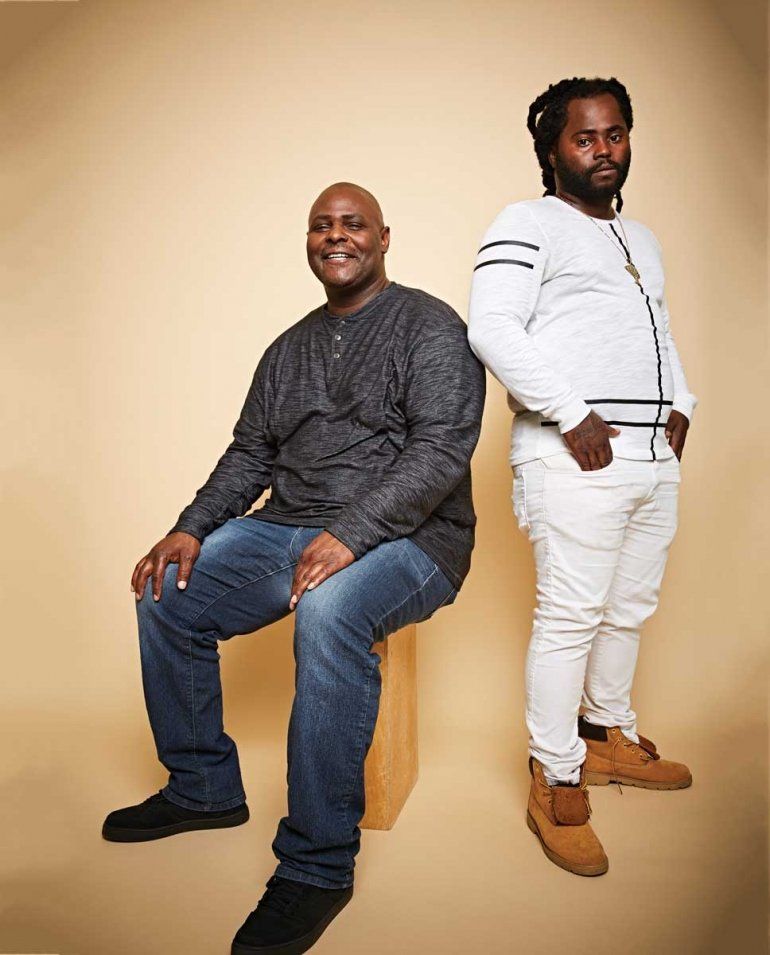
Wrapround case manager Mike Texada (left) has guided Jamal (right) throughout his recovery. Photo: Gabriela Hasbun
Shutting the revolving door
The roots of the Wraparound Project go back to 1996, to a young doctor named Rochelle Dicker, MD, who was doing her surgical internship at San Francisco General Hospital. Dicker had developed a solid rapport with one of her patients, a 16-year-old shooting victim from Bayview Hunter’s Point. “I got to know him quite well,” recalls Dicker. “He told me he wasn’t going to graduate from high school at 18. He thought there was a good chance that he wouldn’t live past 25. He saw no way out, except for his friends protecting him.”
Not yet 30 herself at the time, Dicker was struck by the contrast between her patient’s life and her own, which was just blasting off. “My life bore no resemblance whatsoever to what this 16-year-old was talking about,” she recalls. Shaken by fear, her patient wanted a way out of where his life was headed, but he just didn’t see one. Dicker came to call these windows of opportunity “teachable moments” – times when, with the right intervention, these young adults, mostly men, might redirect their lives.
“I was trying really hard to give him hope, but I couldn’t tell him where to get a good education or a job like the one I had at a bakery when I was 16. I didn’t have any answers for him.”
A few weeks later, her patient was back in the ER with another bullet wound. “It struck me then that violence is a chronic disease,” Dicker remembers. That realization inspired her, some seven years later, to create the Wraparound Project as part of a Violence Prevention Fellowship. Wraparound seizes teachable moments to offer a comprehensive care plan that encompasses financial relief, housing, trauma recovery, education, and employment. The goal is to help people like her young patient not get trapped into a cycle of violence or retribution and work toward a new life.
What Dicker had witnessed happens with great frequency on a national level. The strongest risk factor for violent injury is a history of previous violent injury. In fact, for someone who has been a victim of violence, the chance of reinjury is as high as 45 percent and death from violent injury is twice as likely. Yet by the time Wraparound was just 10 years old, it had changed that grim statistic within the city of San Francisco. By 2008, the project had reduced injury recurrence from 16 percent during the five years before its inception to 4.5 percent during its first five years of operation. Today, Dicker focuses on developing hospital-based injury prevention programs modeled on Wraparound. With five colleagues – surgeons, emergency medicine physicians, and public health professionals – from around the country, she formed the National Network of Hospital-Based Violence Intervention Programs (NNHVIP). Together, they have now created 34 such programs nationwide.
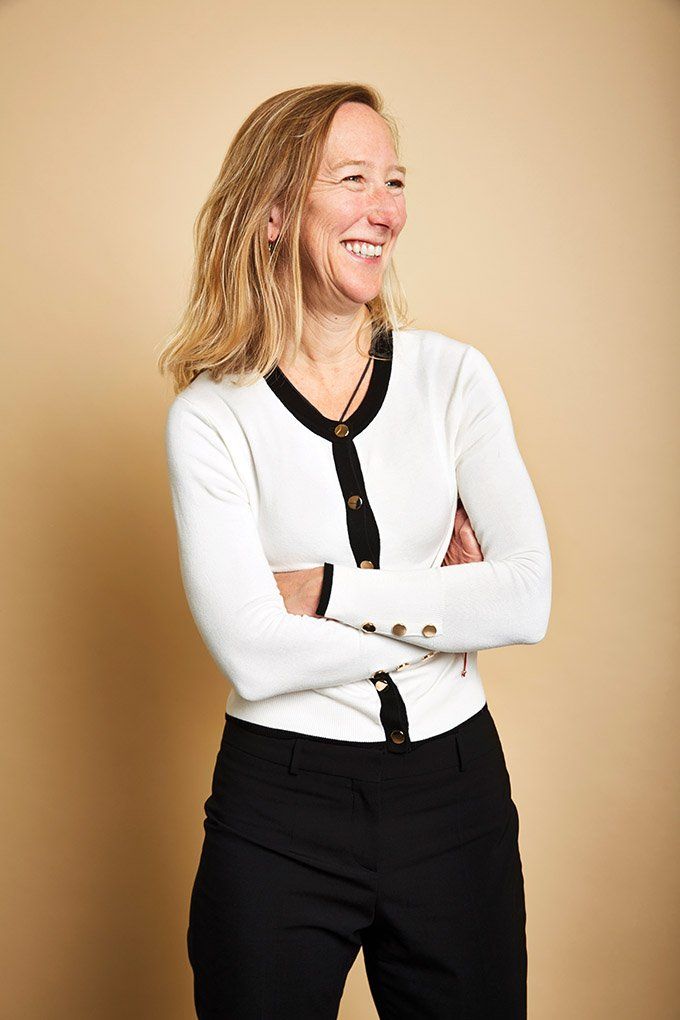
Surgeon Rochelle Dicker’s experience with a teenage gunshot victim during her UCSF internship sparked her idea for Wraparound. Photo: Gabriela Hasbun
Seizing the moment
The Wraparound Project is housed in a spartan space at ZSFG, with just enough room for its director, Catherine Juillard, MD, MPH; four case managers; and an injury prevention coordinator, Adaobi Nwabuo, MBBS, MPH. It’s situated right behind the emergency room so that Mike Texada and the other case managers can readily appear at the bedsides of young victims of violent crime, to make sure no window of opportunity passes without someone there to reach through it, hold the patient’s hand, listen hard, and guide them toward resources. The case managers work to make victims feel whole, safe, and independent enough to break out of the cycle of violence.
“To me, the teachable moment is really when the client has bare sight, when you have that real one-on-one conversation, without all the negativity that’s been around their lives, without all the stuff that they’ve been trying to deal with on their own,” explains Texada. “It’s when you tell them, ‘Yes, you can graduate, you can get a job, you can get off probation, you can get off parole.’”
Texada speaks with the authority of authenticity. Born and raised in the projects in San Francisco’s Western Addition neighborhood, Texada has a story of his own – one that he shares openly and that his clients are very familiar with. He was busted twice for hustling drugs and did time in a state penitentiary in Susanville, Calif. “I changed my path for the love of my children,” says Texada. “I decided that I really didn’t want to be part of the problem. I wanted to be part of the solution.” For the past 12 years, he has led by example through the Wraparound Project and recently received the NNHVIP’s Willis Young Award for his extraordinary efficacy.
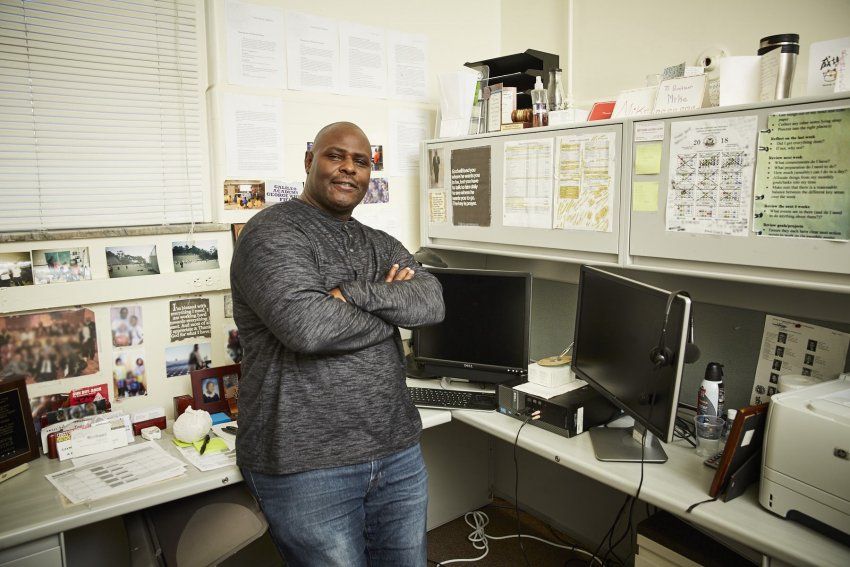
UCSF Wraparound Project case manager Mike Texada in his office, situated just behind the ZSFG emergency room. Photo: Gabriela Hasbun
Piece by peace
Even before Jamal was shot, his life wasn’t easy. His mother died of a heart condition when he was 16 years old. He lived with his father and aunt in the Fillmore. His little brother had at one point been removed from the household by protective services while his father fought through some drug issues. “I grew up seeing a lot people I know personally dying from gun violence in this city,” says Jamal. “And a lot of those friends died at the General [ZSFG].”
So Texada seized the teachable moment that opened up for Jamal during his recovery from his own shooting. Jamal had to undergo reconstructive surgery to piece his face back together. The hospital bills were insurmountable. Texada connected him with Victims of Crime, a national victims’ rights nonprofit, to help him pay for his care. But even now, seven years later, Jamal is still trying to earn enough money for dental implants. Standing next to him, you wouldn’t know that a scalpel – much less a bullet – had ever touched his face. The work is seamless. “But I can feel it from the inside,” Jamal says.
Putting Jamal’s face back together was far easier for his surgeon than the task confronting the Wraparound team: making Jamal feel whole and safe. “Our clients need to address their mental health issues before they can work on their other needs,” says Nwabuo, who manages Wraparound. “Even though mental health is very stigmatized, we match about 75 percent of our clients with mental health services at UCSF’s Trauma Recovery Center. These therapists are very cognizant of the people they serve, and our clients respond very well,” she says. Indeed, Jamal was so traumatized by the shooting that, at first, he was afraid to leave his home. “At the beginning, I was afraid of cars, especially cars with tinted windows, afraid to get on buses, afraid to be around groups of people, afraid of walking, afraid of friends. I didn’t know who shot me. It could have been anybody,” says Jamal. Wraparound connected him with a psychiatrist and a trauma recovery specialist. He saw them for years.
Tyranny of trauma
Lynsey Clark, a clinical social worker at UCSF’s Trauma Recovery Center, works two days a week with Wraparound clients. She helps them come to terms with the trauma of the physical incident that landed them in the hospital as well as, for most of them, the trauma of living in communities infused with violence. The two are intermingled. “Being a victim of a violent crime really changes your perspective about life, your mortality, and your relationships,” she says. Her clients suffer from hypervigilance, avoidance, nightmares, and flashbacks – all hallmarks of post-traumatic stress disorder (PTSD). “If patients don’t get treatment for PTSD, their worlds get smaller and smaller,” Clark adds. “Avoidance can be especially undermining.” By being so fearful of leaving his house, Jamal couldn’t finish his degree or get a job. His life came to a standstill.
The teachable moment is when you tell them, ‘Yes, you can graduate, you can get a job, you can get off probation, you can get off parole.’”
Although his former employer encouraged him to come back to work – even bringing balloons and get-well letters to the hospital – Jamal said no. The landscaping job would take him into parts of the city where he didn’t feel safe. If Jamal had been his family’s primary breadwinner, as many Wraparound clients are, the loss of his income would have been devastating, completely undermining the entire family’s economic standing. "If you can’t leave your house, you can’t hold down a job, and you can’t contribute to the family income,” says Clark. “If you were the primary breadwinner, your role has fundamentally changed within the family. That changes how you feel about yourself, about others, and the world."
Clark helps Wraparound clients set new goals. “For some clients from communities of violence who have experienced multiple traumas, their goal might be to sleep through the night without a nightmare or ride the bus without having a panic attack,” says Clark. Jamal credits his therapist with teaching him how to cope. “I now know steps to take if I go into a panic attack. I can take time to gather my thoughts, get my consciousness together and make better, rational, safe choices in the moment,” he says.
Jamal is now able to ride the bus – yet like many other Wraparound clients, he spends hours taking indirect routes so he can circumvent dangerous neighborhoods. “The reality of it all is that if something you are afraid of is really out there,” says Jamal, “the coping part doesn’t matter.”
Closing the wound
Jamal has come a long way over the past seven years. He has tapped into every resource Wraparound offers. Texada helped him enroll in Five Keys Charter School so he can finally finish his GED. Jamal has used Wraparound’s Advocacy Center to get tutoring help along the way. Wraparound’s Job Readiness Training program helped him develop a resume and interviewing skills, which enabled him to land a job at a shelter for juveniles who have been removed from their families.
A Wraparound volunteer also taught Jamal how to paint. His first painting was a portrait of his mother. He has painted her image time and again, each time straying more freely from what she looked like and delving more into what she represents – a source of love, happiness, and, in her absence, pain. He paints a broad range of other subjects, too – from the Simpsons, to wild creatures of the night, to the galaxy. He has now produced dozens of paintings, his work has appeared in shows, and he successfully sells his art.
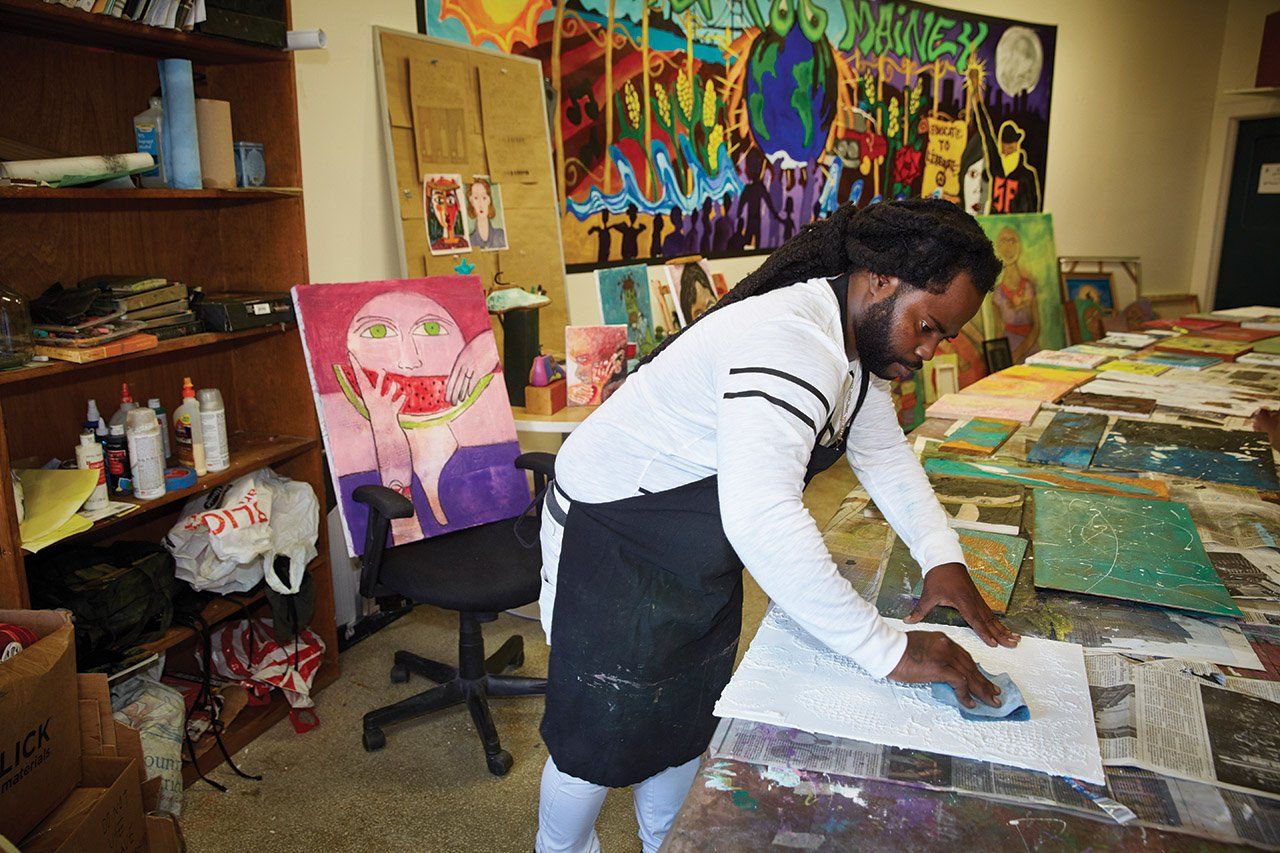
A Wraparound Project volunteer taught Jamal to paint. His work, which covers a broad range of subjects, has been featured in multiple shows. Photo: Gabriela Hasbun
Today, Jamal considers himself an advocate for victims of violence. In this capacity, he is paying forward all he has learned from Texada. “Jamal has potential as a peer leader,” says Texada. “He is inspiring in intimate settings, when people need help identifying who they are and what they need.” The two work together in Texada’s Weapons in Minors’ Possession Program, which invites kids who have been busted for carrying guns to come to ZSFG. There, Texada and Jamal tell them cautionary tales of the path that weapons might lead them down.
Jamal speaks to these kids knowing exactly where they are coming from. They are just trying to survive a world that is falling down around them. “Some of these kids have brothers and sisters who were murdered, fathers and mothers on drugs. Some never even knew their parents and are growing up in a bad community witnessing a whole bunch of different things,” explains Jamal. “The brain can be sculpted any type of way. These situations in neighborhoods – what kids see – it affects how they interpret life and how they want to live it.” Acquiring a gun in such a scenario might make them feel safer. Jamal’s message is that owning a weapon never ends well.
“I tell them there’s always a way out. I tell them to pay attention in school, to graduate on time, to ignore the cool kids with the Jordans,” says Jamal. “Trying to get those shoes is a gateway to everything else that’s negative in the world – stealing, selling drugs. It’s hard for them to see the pros when there are so many cons in their world. This is my perspective on how we can help the world.”
Jamal now gets letters from kids telling him how he has righted their course. “Mike Texada put one on his wall,” says Jamal, beaming. It’s clear that Texada’s approval means everything to him. Yet it has to be earned, and Jamal is currently working furiously to win it back. He was recently busted on a weapon possession charge, so Texada suspended him from his advocacy role until he pulls himself back together. “I have a lot of love, but it is tough love,” says Texada. “I don’t have sympathy when you make mistakes that you know better than to make. I want him to man up and take responsibility.” But the “love” part is that Texada has gone to a couple of court sessions with Jamal to advocate for him.
By reaching victims of gun violence and other crimes in the early days after injury, the UCSF Wraparound Project has reduced recurrence by 70%.
Having had setbacks of his own, Texada sees this as the rough terrain Jamal must get through to become an adult. There’s no easy way out of the cycle of violence. The pictures on Texada’s wall – a mosaic of faces – tell that story all too well. Some of those faces have the doughy look of middle school, others have the finer chisel of young men in their twenties. Nearly all are boys and men of color. Texada can swivel around in his desk chair and name each of them – where they are, what they are up to. “I still talk to this guy,” he says, pointing to a picture of fifth-graders around a craft table. “He’s in jail for attempted murder; his brother was murdered yesterday. This guy just got out for attempted murder,” he continues. “He’s got a job right now. Just had a new baby. And this young man just did a rap song that went viral. He’s going to start making some money.” All told, their stories trace the arc of Texada’s career, from his early work as a school site mentor, intervening with troubled kids for an antiviolence group called Brothers Against Guns, to his current position at Wraparound.
“Yeah, I had some of these guys in grammar school. Now I see them coming through the trauma bay,” says Texada, with a wince. He has spent seven years making sure Jamal’s story is a long and positive one.
“There have been times when I’ve strayed away from this program, times I might have started things that I didn’t finish,” says Jamal. “But I always come back. The door never closes.”

